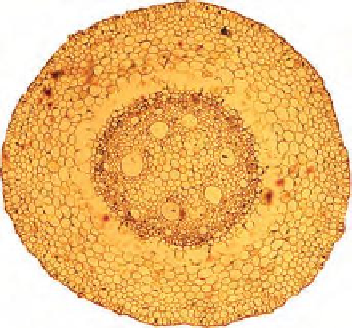Agriculture Reference
In-Depth Information
Epidermis
Cortex
Endodermis
Pericycle
Xylem
Phloem
Figure 6.7
Transverse section of a monocotyledonous
root in
Zea mays
(sweetcorn)
(a) stem
Apical meristem
Zone of cell
division
Figure 6.9
A root tip showing the protective root cap
Bud primordium
Zone of cell
elongation
Leaf primordium
Initially the new cells are unspecialized or
undifferentiated, but once expanded, cells change
their structure and chemistry to adopt their final role.
Their cell walls become rigid and the connections
between cells (plasmodesmata) form. The exact shape
and chemical composition of the wall is different for
each type of tissue cell, since each has a particular
function to perform. This takes place in the
zone of
differentiation
where the epidermis, cortex, vascular
tissues and pith become distinct.
Leaf structure is described in Chapter 9.
See 'Plants and their Structure' on the companion
website for further images.
Cortex
Zone of cell
differentiation
Phloem
Vascular cambium
Xylem
(a)
Pith
Emerging lateral root
Endodermis
Pericycle
Phloem
Further reading
Zone of cell
differentiation
Vascular cambium
Capon, B. (2005)
Botany for Gardeners
. Timber Press.
Clegg, C.J. (2003)
Green Plants: The Inside Story.
III
Advanced Biology Series. Hodder Murray.
Clegg, C.J. and Cox, G. (1978)
Anatomy and Actvities
of Plants.
John Murray.
Hodge, G. (2013)
RHS Botany for Gardeners.
Mitchell
Beazley.
Ingram, D.S., Vince-Price, D. and Gregory, P.J. (2008)
Science and the Garden
.
Blackwell Science.
Lack, A.J. and Evans, D.E. (2005)
Instant Notes in
Plant Biology.
Taylor & Francis.
Sugden, A. (1992)
Longman Botany Handbook.
Blackwell.
Root hair
Xylem
Zone of cell
elongation
Zone of cell
division
Apical meristem
(b)
Root cap
Figure 6.8
Longitudinal sections through a
dicotyledonous stem and root tip showing zones of cell
division, growth and differentiation: (a) stem; (b) root
Please visit the companion website for further information:
www.routledge.com/cw/adams


































































